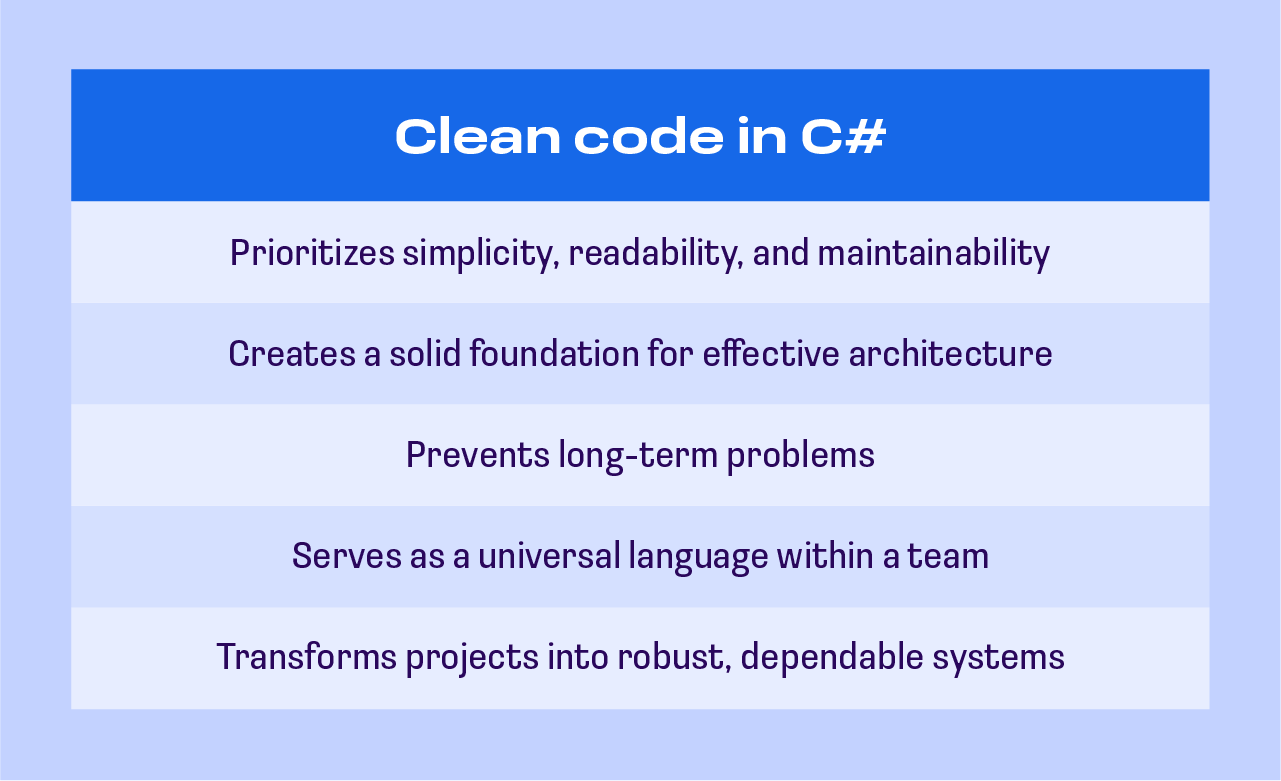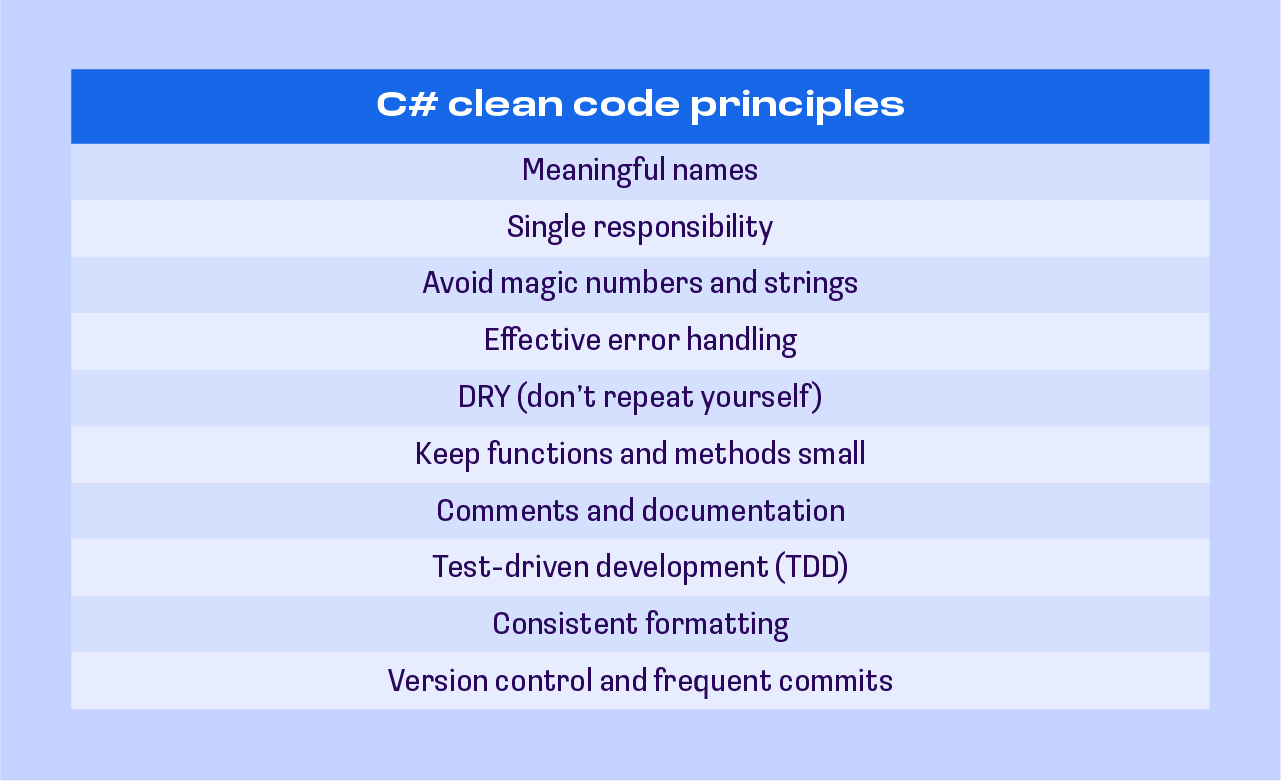Master the art of writing clean code in C#
The author of this article is tech expert Pieter Murphy.

Writing code is more than just getting an application to function – it’s about crafting something that is efficient, maintainable, and a pleasure for others to work with. For anyone looking to master the art of writing clean code in C#, achieving this level of skill transforms programming from a technical chore into an elegant and thoughtful endeavor. Whether you’re debugging your own code months after you’ve written it or collaborating with a team, clean code stands out as the difference between a seamless experience and endless frustration.
The journey to becoming a more mindful developer starts with understanding that clean code isn’t a destination; it’s a continual process. Every decision, from how you name variables to how you structure your methods, contributes to the readability and functionality of your programs. While some view coding as purely a technical skill, those who excel know it’s an art form that balances logic with clarity and simplicity.
Introduction: what is clean code and why is it important in C#?
Clean code refers to a programming approach that prioritizes simplicity, readability, and maintainability. It goes beyond merely writing functional programs – it’s about ensuring that the code is clear, concise, and easy to understand for anyone who might work with it, whether today or years down the line. In the context of C#, clean code is particularly vital because the language's versatility and widespread use mean projects can vary greatly in size and complexity. A well-structured and organized codebase creates a solid foundation for effective C# clean code architecture, ensuring that the software remains adaptable and scalable over time.
Writing poor-quality code may work in the short term, but it often leads to significant long-term problems. Hard-to-read code slows down debugging, increases the likelihood of introducing bugs, and can make onboarding new team members an uphill battle. The consequences of messy or overly complicated code can ripple through a project, delaying timelines and inflating costs. Conversely, when developers write clean code, it eliminates unnecessary obstacles, fostering a more efficient development process while improving the overall quality and reliability of the software.
Clean code also serves as a universal language within a team, offering clarity to anyone who reviews, tests, or updates a program. It eliminates the need for cryptic comments or lengthy explanations, as the code itself effectively communicates its intent. Whether you’re scripting a complex enterprise solution or a lightweight tool, adhering to clean coding principles ensures a smoother workflow and reduces the time spent deciphering unclear logic. In the long run, clean code and clean architecture transforms a project from being a fragile, tangled script into a robust, dependable system that stands the test of time.

C# code principles guide
Meaningful names
Choosing meaningful names is a cornerstone of clean coding practices. A well-named variable, method, or class makes your code self-explanatory and eliminates the need for excessive comments. For instance, compare these two snippets:
The second example provides clarity and context, making the code easier to understand at a glance. By prioritizing descriptive names, you ensure that your code is accessible to others and yourself in the future. Implementing this habit consistently will strengthen your clean code C# practices and lead to more maintainable applications.
Using meaningful names also reduces cognitive load when debugging or extending your program. When names are clear, it’s easier to locate issues or build upon existing functionality without misunderstanding the code’s intent. Strive to use names that describe "what" the code is doing, leaving "why" to comments only when necessary. This approach ensures your code remains intuitive and developer-friendly.
Single responsibility
The single responsibility principle - which is part of the SOLID (Single responsibility, Open-closed, Liskov substitution, Interface segregation, and Dependency inversion) strategy - states that a class or method should have only one reason to change. In practical terms, each component of your code should focus on one job, which makes it easier to test and maintain. For example, instead of writing a method that calculates an order total and sends an email confirmation, break it into two separate methods:
By adhering to this principle, you ensure that each piece of your code has a clear focus, making it easier to debug and extend. This approach is crucial for any software engineer aiming to write scalable and reliable applications.
When responsibilities are split logically, testing becomes more straightforward. Each method or class can be validated independently, leading to faster development cycles and fewer bugs. This modularity is key to creating a robust and adaptable codebase that can evolve as project requirements change.
Avoid magic numbers and strings
Magic numbers and strings – hardcoded values without explanation – are one of the quickest ways to make your code confusing and error-prone. Instead of embedding these mysterious constants throughout your code, define them as named variables or constants. Consider this example:
Bad Example:
Good Example:
The second example is much clearer and follows solid principles for maintainable code. Anyone reading the code can instantly understand the logic and adjust the constants without searching for all occurrences of the hardcoded values.
Avoiding magic numbers and strings also reduces the risk of errors during updates. If a value like a discount rate needs to change, you only need to update it in one location. This small adjustment can save hours of debugging and improve the overall reliability of your code. By following these clean code C# examples, you create a more professional and user-friendly codebase.
Error handling
Effective error handling is critical for writing robust and reliable code. In C#, this often involves leveraging `try-catch` blocks and custom exceptions to ensure your application gracefully recovers from unexpected issues. For instance:
This approach not only prevents your program from crashing but also makes debugging easier by providing clear error messages. To follow C# clean practices, avoid generic error handling that swallows exceptions without logging them, as this can lead to hidden bugs.
Additionally, aim to centralize your error-handling logic to ensure consistency across your codebase. A dedicated error-handling strategy, such as creating custom exceptions or using middleware in a web application, aligns with well-structured architecture principles and reduces duplication. By prioritizing thoughtful error handling, you enhance both the user experience and the maintainability of your application.
DRY (don’t repeat yourself)
The DRY principle encourages you to eliminate redundant code by reusing functionality wherever possible. Repetition not only bloats your code but also increases the likelihood of errors when changes are needed. Consider this example of repetitive code:
Applying the DRY principle, you can refactor the shared logic into a reusable method:
By reusing logic in this way, you reduce maintenance efforts and make your code more efficient. DRY is not just about saving time – it also ensures that your application behaves consistently, as updates to shared logic only need to happen in one place. For anyone aiming to write high-quality code, DRY is an essential habit to develop.
Keep functions and methods small
Small, focused functions make your code easier to read, test, and maintain. Each function should ideally perform one specific task, which helps keep complexity under control. For instance, instead of creating a single method that processes an order, calculates taxes, and sends a confirmation email, you can break it into smaller pieces:
This separation of concerns improves readability and allows each part of the process to be independently tested and debugged. Small functions also make it easier to spot and fix errors, which is a key benefit of following C# clean code examples.
Keeping methods small also contributes to better modularity, a cornerstone of clean coding. When each function is focused on a single responsibility, you can reuse it across your application without introducing unnecessary dependencies. This approach not only simplifies debugging but also aligns with the best practices of building scalable and maintainable systems.
Comments and documentation
When it comes to how to write clean code C#, comments and documentation serve as the voice of your code, explaining the "why" behind your implementation choices. While clean code should largely speak for itself, there are moments when a well-placed comment can clarify intent or provide context. For example:
Good documentation can make onboarding new developers seamless and ensure that everyone understands how to use a class or method. Avoid overusing comments to explain obvious logic – it’s better to focus on meaningful insights. Following a manual style for your documentation, such as XML comments in C#, provides a consistent and professional structure.
Using tools like XML documentation also allows you to generate a reference guide directly from your code. For instance, adding XML comments above a method:
This ensures your documentation doubles as both instruction and a development resource, improving clarity and team collaboration.
Test-driven development (TDD)
Test-driven development (TDD) flips the traditional coding workflow by starting with tests before implementing functionality. The process involves writing a failing test, implementing the code to pass the test, and then refining the implementation. For example, in C#, you could start with a simple test using a framework like NUnit:
This approach ensures that your code meets its requirements before you even start writing logic, reducing bugs and increasing confidence in your work. TDD aligns perfectly with clean code C# examples, as it encourages smaller, testable methods that adhere to single responsibility and clarity.
By adopting TDD, you also improve your code's flexibility. Refactoring becomes safer, knowing that a robust suite of tests will catch regressions. Over time, this leads to higher-quality software and a more efficient development cycle. When you create code with testing in mind, you naturally build systems that are easier to maintain and expand.
Consistent formatting
Consistent formatting is essential for maintaining readability and professionalism in your code, making it a core part of C# clean code architecture. Along with embracing clean code on an individual level, establishing team-wide coding standards ensures consistent formatting and style across projects. This strategy ensures that anyone reading the code – whether it’s you, a teammate, or a new developer – can quickly understand its structure and flow. For example, sticking to a consistent style for indentation, spacing, and naming conventions can transform a chaotic codebase into a well-organized one. Consider this formatted code snippet:
Adhering to C# clean code principles means not just writing functional code but ensuring it’s visually intuitive. Using tools like Visual Studio’s built-in code formatter or third-party extensions can automate the process and help enforce a consistent style across your project. A well-formatted codebase not only improves collaboration but also reduces time spent deciphering poorly formatted sections.
Version control and frequent commits
Version control is a foundational best practice for modern software development, and tools like Git make managing code changes seamless. When paired with frequent commits, version control allows you to track progress, roll back errors, and collaborate effectively with a team.
Platforms like GitHub take this a step further by enabling code reviews and collaboration across teams, ensuring that your code is reviewed and maintained efficiently. Frequent commits also make debugging easier since you can pinpoint the exact moment a bug was introduced by reviewing the commit history.
Using version control fosters accountability and transparency while enabling you to maintain a clean, reliable codebase. Whether you’re working solo or as part of a team, integrating regular commits and leveraging version control tools is critical for building scalable and maintainable software.

How we can help you
Achieving engineering excellence goes beyond just understanding coding concepts – it requires mastering practices that ensure your code is efficient, maintainable, and scalable. Our focus is on empowering developers to elevate their skills through practical, hands-on learning. Whether you're aiming to improve your understanding of how to write clean code in C# or refine your ability to review and optimize code, our specialized courses are designed to guide you every step of the way.
Engineering Excellence (EngX) is about setting a higher standard for yourself and your team, and we’re here to help you achieve that.
Conclusion
Mastering the art of clean code in C# is more than just a technical achievement – it’s a commitment to creating software that is efficient, maintainable, and scalable. By focusing on C# clean code architecture and coding principles like meaningful names, single responsibility, and avoiding magic numbers, you lay the foundation for a codebase that is not only functional but also future-proof. Clean code fosters better collaboration, reduces debugging time, and ensures that your applications can evolve alongside your business or personal projects.
The journey toward cleaner code is one of continuous improvement and learning. Whether you’re refining your error-handling techniques, embracing test-driven development, or exploring new tools, every step forward strengthens your skills as a developer. By prioritizing these practices, you’re not just writing code – you’re crafting solutions that stand the test of time. Commit to clean coding today, and experience the difference it can make in your projects and career.
FAQ
How to make C# code more efficient? (expert)
According to Lead Software Engineer at EPAM and the alumnus of the EngX Clean Code course, Bohdan Boichenko, “Code efficiency isn't solely about performance. It also encompasses resource management, maintainability, and scalability. Efficient code should be easy to read, understand, and modify, which promotes long-term project sustainability.
“To create efficient and clean code in C#,” he continues, “prioritize clear and concise logic, choose the right data structures, and utilize asynchronous programming for optimal resource management.”
How to write clean code in C#? (expert)
“Writing clean C# code involves adhering to principles such as SOLID, DRY, KISS, and YAGNI,” says Bohdan Boichenko. “Ensure methods and variables have meaningful names and single responsibilities. Implement static analyzers and configure them appropriately to maintain consistent coding standards and catch issues early.”
How to run code cleanup in C#? (expert)
“You can use any built-in Code Cleanup feature available in your preferred IDE to automatically apply formatting and style rules,” states Bohdan Boichenko. “Additionally, utilize refactoring tools and the "dotnet format" command-line tool to systematically standardize and maintain a clean and consistent codebase.”
Is clean code a skill?
Yes, clean code is absolutely a skill, and like any other skill, it requires practice, refinement, and a commitment to improvement. Writing clean code goes beyond basic syntax or getting a program to work; it’s about creating code that is easy to read, maintain, and extend. This skill combines technical knowledge with an understanding of how to write clear and efficient logic that others can follow. Over time, developers who prioritize clean code develop a mindset of intentionality and attention to detail, transforming their codebases into assets rather than obstacles.
Developing clean code as a skill involves adopting specific principles and cultivating habits that ensure clarity and structure. Skills like using meaningful names, adhering to single responsibility principles, and avoiding unnecessary complexity are all integral to clean code. These practices don’t come naturally to everyone but are developed through experience, mentorship, and a willingness to learn. The more you practice clean coding techniques, the more they become second nature, enhancing your overall effectiveness as a developer.
How do you teach clean code?
Teaching clean code involves more than just presenting concepts – it requires a hands-on approach that encourages active learning and practical application. Start by introducing the foundational principles of clean code, giving learners a solid starting point. Examples and counterexamples can be highly effective in helping learners recognize the difference between clean and cluttered code. Pairing these lessons with real-world scenarios and projects ensures that learners see how these principles apply in practice, reinforcing their understanding.
Feedback is an essential component of teaching clean code. Code reviews, for instance, allow learners to receive constructive feedback and identify areas for improvement. Additionally, interactive tools, exercises, and courses, like the EngX Clean Code Course, provide structured opportunities for learners to engage with the material in a meaningful way. Teaching clean code is about more than just conveying knowledge – it’s about empowering developers to apply these practices confidently and consistently in their own projects.


_(1).png)
.png)